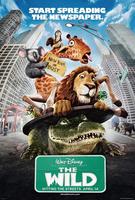
The Wild
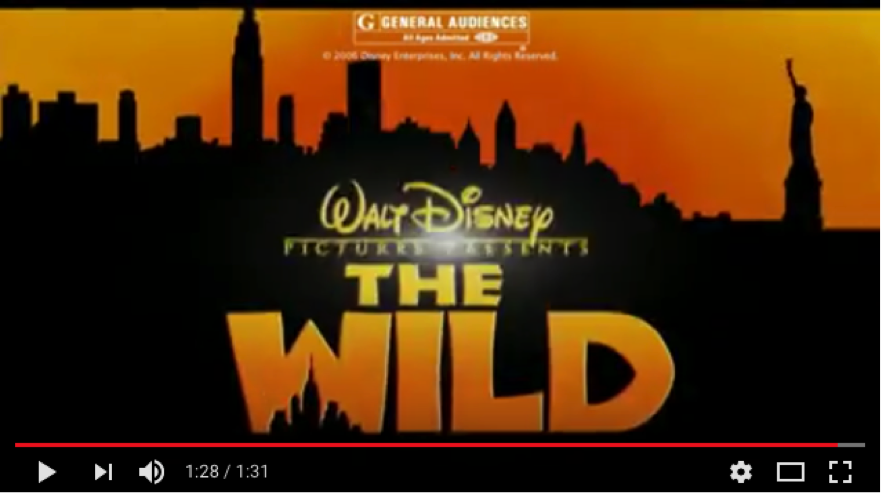
YouTube video of the film’s theatrical trailer: <https://www.youtube.com/watch?v=zE3mEgqqlCM>
‘Start spreading the newspaper.’
Disney’s 2006 animation, The Wild, by first-time director and ex-special effects artist Steve ‘Spaz’ Williams, is a family comedy film centred on a group of zoo animals: Samson the lion, Bridget the giraffe, Nigel the koala and Larry the anaconda. Along with their squirrel friend, Lenny, the quintet find themselves lost in the wilderness of the jungle after pursuing Samson’s son, Ryan, when he is accidentally transported to Africa. Upon arriving in ‘the wild,’ the group unexpectedly ends up entangled with Kazar and his predatory wildebeest cult, who, hilariously believing Nigel to be ‘the Great Him,’ worship the koala as a god who will allow them to ascend from the bottom of the food chain to the top. When Ryan is captured by the cult, Samson ‘The Wild’ must confront his past demons to save his son from being eaten by the wildebeest and restore the hierarchal balance of lions as rulers of the food chain hierarchy.
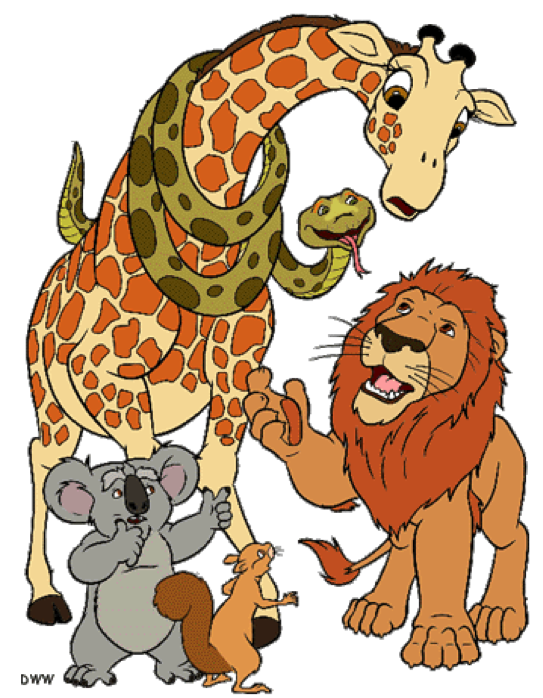
Above: fan-art drawing of the main five characters, Samson the lion, Bridget the giraffe, Larry the anaconda, Nigel the koala and Lenny the squirrel. Image from http://www.disneyclips.com/imagesnewb3/thewild.html
‘Don’t be mistaking this for a Madagascar rip-off.’
Despite being heavily criticised for its similarity to DreamWorks’s Madagascar (2005) for the choice of animals used and the basic escape storyline (from almost the same locations: a zoo in New York to an African region!), The Wild’s plotline differs in that it is darker and possesses more themes in common with other films from Disney’s own canon. The fragile father-son relationship leading to the kidnapping of the son and consequential journey-search narrative developed around the bildungsroman of the parent rather than the child is reminiscent of Finding Nemo. The comedy constantly nods self-referentially to The Lion King visually by satirically mimicking shots of infamous scenes, and holding Ryan’s inability to roar, parallel to Simba, as the predominant feature of father-son relationship, maturity and animality. Casting a shadow over The Wild’s comedic genre in the film’s final forty minutes is the interruption of Kazar, whom, gathering an occult following, intends to deconstruct and subvert the accepted speciesist hierarchy of ‘claw over hoof.’ With its focus on the parental figure, and reference to an older 1994 Disney classic, The Wild focuses on gathering a family audience, as these recognisable and nostalgic tropes appeal to older family members as well as children.
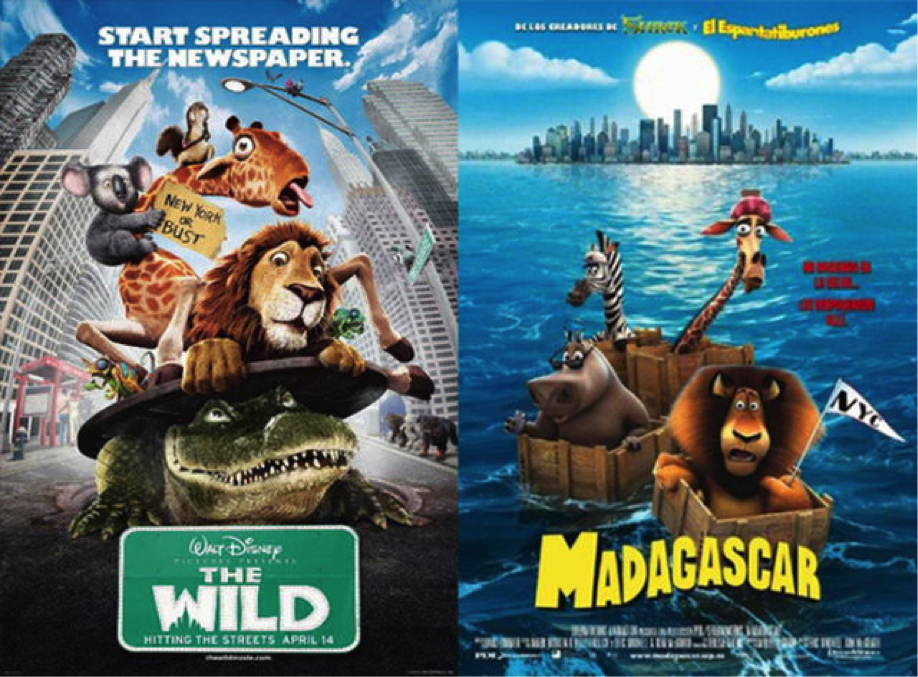
Above: similar-looking film posters for Disney’s The Wild (left) versus DreamWorks’s Madagascar (right). Image from http://img.izismile.com/img/img4/20111022/640/awesome_movies_and_their_copycats_640_03.jpg
‘At long last, the cosmic balance has shifted. Prey has become predator, and predator has become prey. And hoof finally trumps claw!’
Kazar’s desire to replace the lion species as top of the food chain is similar to Jacques Derrida’s concept of ‘carno-phallogocentrism,’[1] where one species is allowed to kill other animals for food, and is therefore the leader of all sentient beings. Evidently, the accepted established order of lion as the top of the food chain in The Wild is a continuation of the previous order already established in The Lion King; as lions are the top hunters, they are the rulers of all other animals. The Wild takes a comedic take on what happens if Wildebeest attempt to overthrow the hierarchy, switching the binaries of ‘hoof’ and ‘claw’ around.
Fig. 1
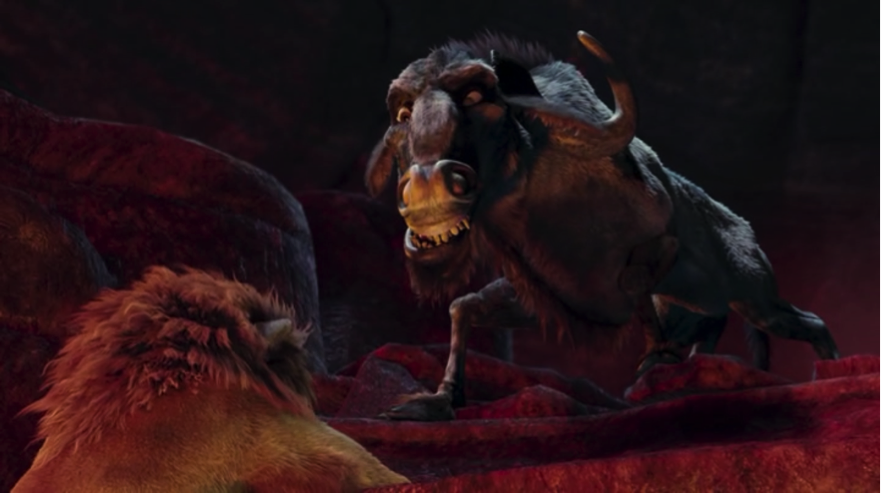
Fig. 2
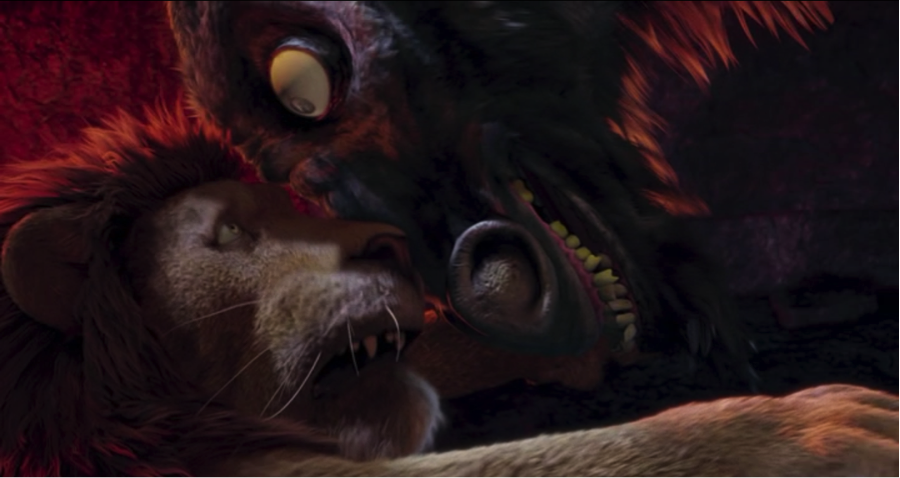
Fig. 3
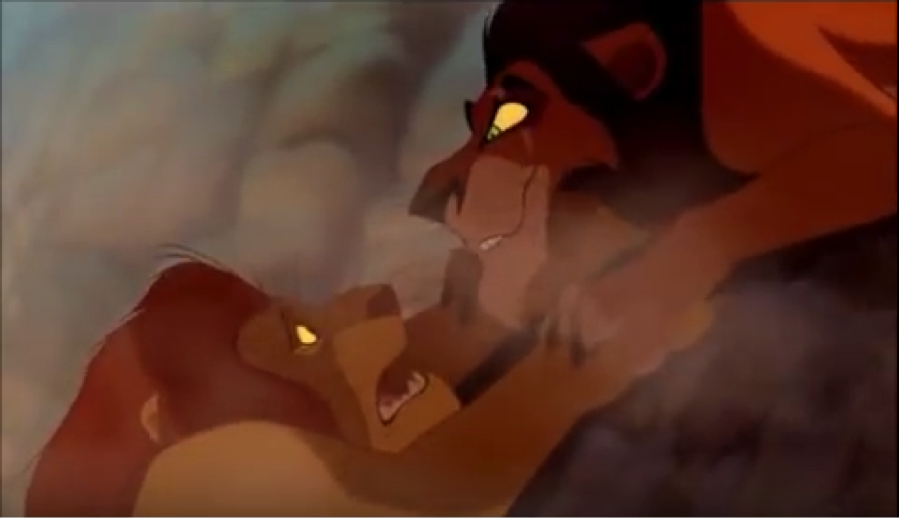
Fig. 4
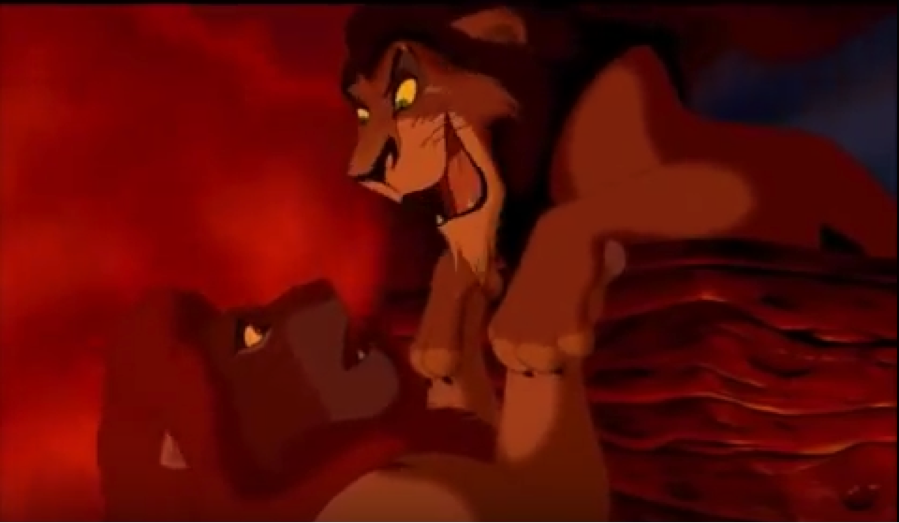
Above: figures 1 & 2 show Kazar standing over Samson whilst he hangs off a ledge, whilst burning lava flows beneath him. Kazar boasts that he will now be ‘top of the food chain’ before stamping on Samson’s paws with his hooves. This is satirically mimicked from the way Scar kills Mufasa (figure 3) by clawing his paws and whispering ‘long live the king’ before throwing him off the ledge to a wildebeest stampede, and his attempt at killing Simba (figure 4) where he repeats the same action when Simba is hanging over a wildfire. In all three instances, the killer is attempting to de-throne the individual hanging over the ledge and take his place as king of all the animals and top of the food chain.
Whereas in reality, ‘carno-phallogocentrism’ relates to the dominant species as man, there are no humans present in the film, allowing for animal politics to dominate the screen, and as the question of food chain hierarchy also takes place entirely once the animals leave the zoo and enter the wild, the discourse on these animal politics takes place within its own secluded space away from the world of human dominance. The issue with this in the world of animation where all species of animal can interact freely with each other – so, in effect, carnivores may be eating their herbivore friends, but this is accepted – is addressed by Paul Wells’ in his ‘Madagascar Problem.’ The Wild’s resolution sees Kazar overthrown by Samson and his friends and wildebeest back at the bottom of the food chain, in their rightful role as prey animals. Kazar is only viewed as the antagonist because he poises a threat to the protagonists of the tale that the audience have become emotionally invested in – despite Samson and his son Ryan being carnivores, who we would perhaps more likely expect to view as the ‘evil’ animals. As our protagonists are grossly outnumbered by the mass of Kazar’s followers, and it is physically impossible for them alone to overcome them, the film relies on the herd of wildebeest to abandon Kazar’s ideologies and turn against him by coming to a ‘moral’ conclusion about their actions: ‘we’re tired of pretending to be something we’re not.’ As Wells states on the ‘Madagascar Problem,’ ‘while this offers some notion of closure, it remains unsatisfactory, both because it reduces a complex animal discourse – which the film has introduced as its core dramatic problem – […] although this outcome is inevitable, given that the film is considered family entertainment, an animation, and a mainstream vehicle, it continues to leave unresolved the question of how these animal discourses may be best read and for what purpose.’[2] It is quite odd, when, immediately after Kazar’s death, the wildebeest flee the island and the exploding volcano by travelling with our two lion protagonists on a boat – with no food. The animation’s comedy quickly avoids and distracts the audience from any further food chain queries with a song and dance on said boat as the animals all return to the New York Zoo.
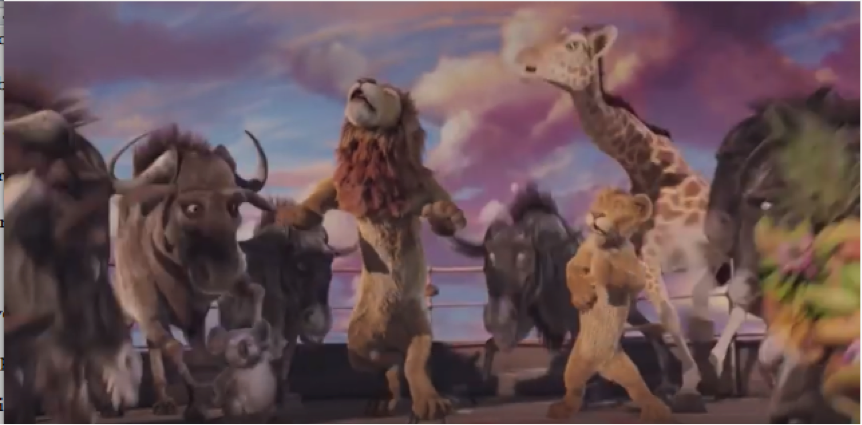
Above: the film’s final scene, showing the animals dancing together in harmony on the boat home to New York Zoo.
The general philosophy in the film is that if things return and stay by their previously established order, all is good and well, despite what implications that order may have. The film’s rules on food chain follow the way ours is biologically established: Lenny states, when glimpsing some unusually scary looking wildebeest, ‘it’s okay – they have hooves! That means they don’t hunt, they graze.’ It emphasises just how ‘unnatural’ Kazar’s ideas are by building his philosophies around a dramatically ironically false religion. As a youngster and about to be killed by three lionesses, a stuffed pull-string toy falls from an overhead helicopter and lands in between Kazar and his hunters, and, with the ‘I’m so cuddly’ speech triggered on the impact of landing, scares away the three lionesses. This toy is a souvenir of Nigel from New York Zoo, whom is the least aggressive, most pampered and ‘civilised’ of all the characters in the film – obviously not the kind of god to subvert the established hierarchy of predator over prey into ‘hoof over claw.’ Such a set up really emphasises that there is one way things should be, to the point that a subversion of the roles is so ridiculous that it is really quite hilarious to be put in actuality.
‘If you really wanted me to roar like you, you’d take me to the wild.’
The film’s main focus, however, is around the father-son relationship between Samson and Ryan. Ryan is struggling finding his ‘roar;’ like in The Lion King, the ability to roar not only reflects maturity but allows one to assert oneself as a powerful lion: the ‘king’ of all animals, being the species at the top of the food chain.
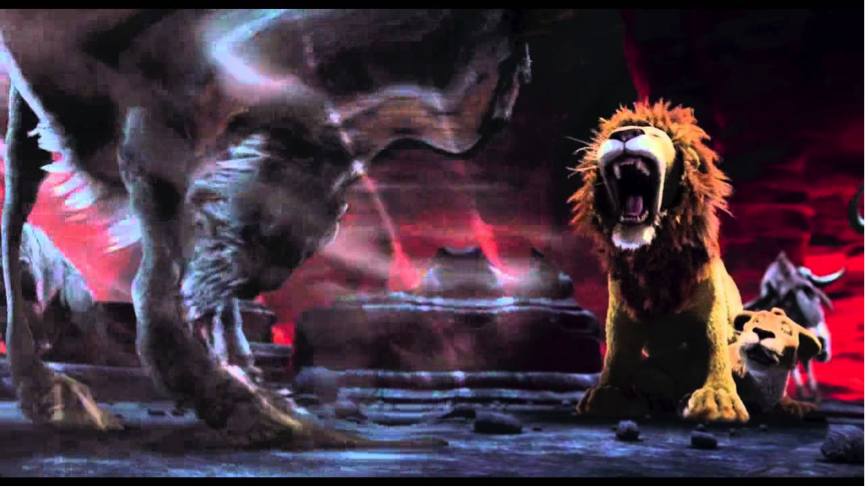
Above: the power of the roar!
However, whilst Ryan is struggling through his development into maturity, The Wild actually focuses more on the father’s learning process than the child’s, much like Pixar’s Finding Nemo. As Samson ‘The Wild’ is insecure about his real past – not being from the wild, like his other zoo companions, but bred in a circus – he tells his son outlandish fantasies about the time he lived in the wild, ‘to inspire him’ to find his ‘roar.’ The issue here is that Ryan believes his ‘roar’ will only come to him if he experiences the wild for himself, and Samson’s refusal to admit the truth about his history adds to his son’s frustration and insecurity, building an unrealistic expectation around living up to his father. In effect, the pair shares the same insecurities about being raised in captivity, feeling they lack animality – Ryan cannot roar, and Samson admits, once in the wild, that he cannot hunt, cannot ‘protect’ his friends, and cannot ‘take the wildebeest.’ Once the pair are in the wild, they realise ‘you come from a long line of kings […] it doesn’t matter where you’re from – zoo, jungle, goldfish bowl – it’s what’s in here [inside].’ So, in effect, they do not have to experience the wild to possess true animality: as a result of their genetic family history, it already exists inside them. But strangely, and perhaps grossly overlooked by the film, it is only once they are actually in the wild that they realise this.
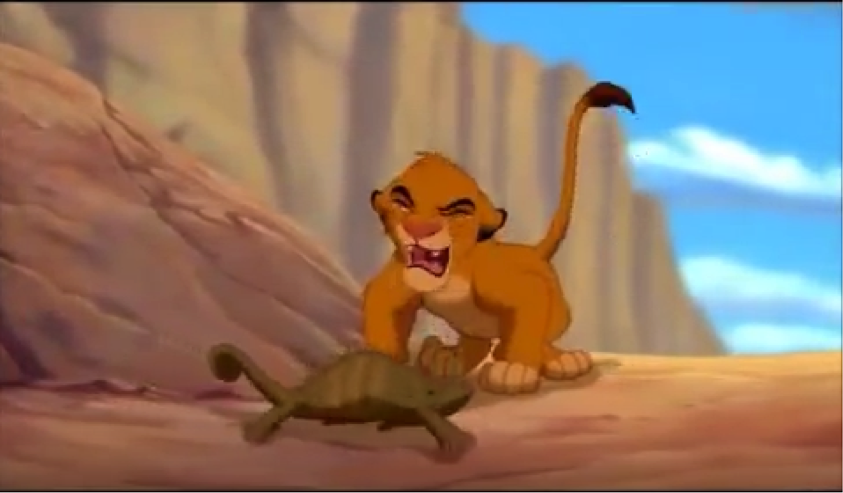
Above: Simba from The Lion King practicing his underdeveloped ‘roar.’
Below: Ryan attempting (and failing) to find his ‘roar.’
The ‘roar’ in relation to maturity and animal power is another theme uplifted from Disney’s older classic.
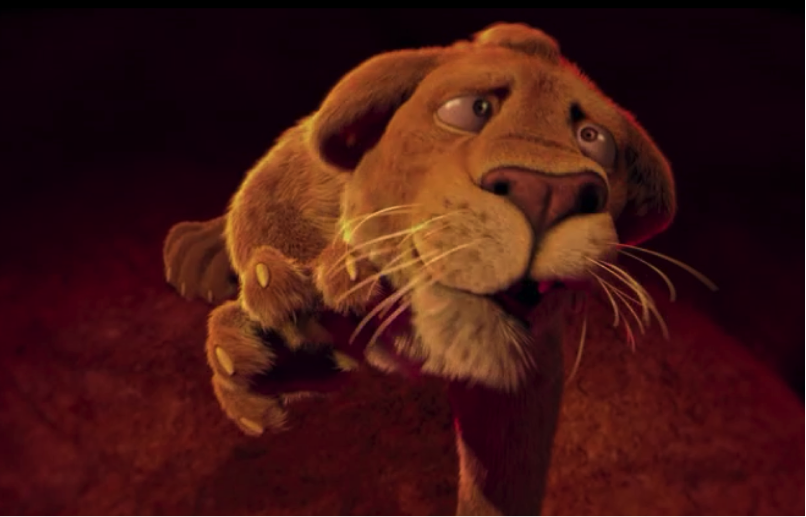
‘Who knows how to steer? None of us. We’re animals. GREAT!’
One aspect that appears clear throughout the plotline of The Wild is the animal’s roles in life are ruled and restricted by their biological species. This can be a good thing, i.e. Samson and Ryan can both be the fearsome lions like the wild ones they aspire to be even if they are kept in a zoo, and will always remain at the top of the food chain by effectively being born into a family of kings. However, attempts to challenge the established hierarchy of animals deems you, as Lenny denotes the wildebeest ‘the freaks with the hooves,’ an eccentric whose ideals are so ridiculous in a world ruled so strongly by the laws of biological evolutionary science, that you must be corrected. The open interaction and friendship between the lions and the other main characters, who are prey animals, is also complicated by the film’s logic when Samson and Ryan happily consume meat steaks in the zoo and the normality of this is so readily accepted that it appears to raise no distaste amongst any of the animals in the film. In the world of animated comedy, however, all of these issues are expected to be readily accepted and overlooked just as easily by the audience as by the animated animals themselves.
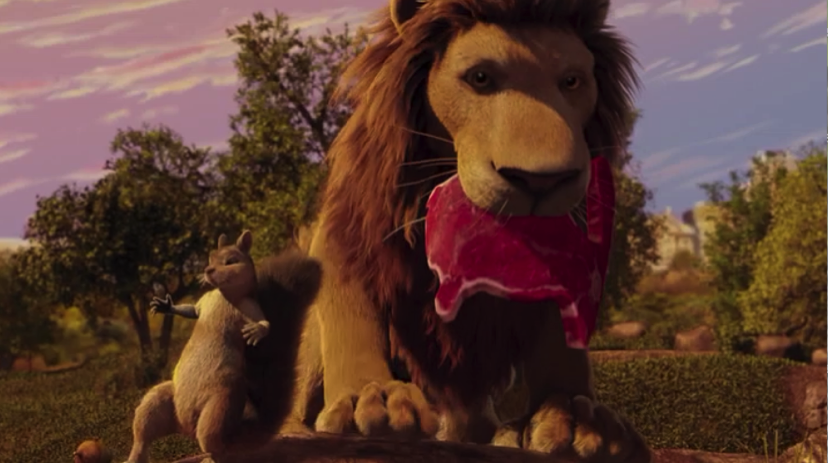
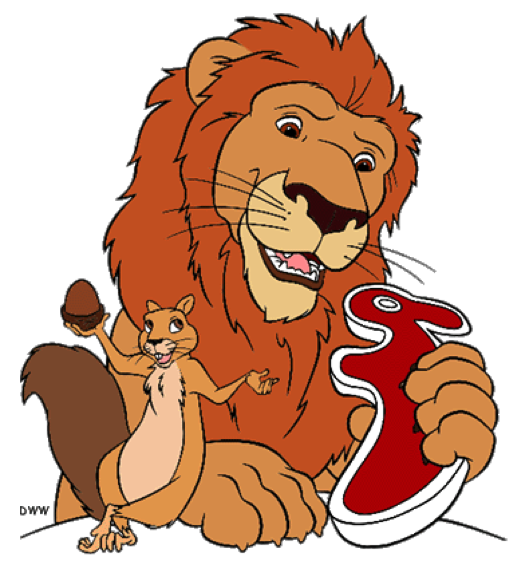
Above images: not weird at all. Samson eats a rabbit in the presence of his best friend, who also happens to be a rodent. Clip art from http://www.disneyclips.com/imagesnewb3/thewild.html
Filmography
- The Lion King dir. Roger Allers and Rob Minkoff. Disney, 1994
- The Wild dir. Steve ‘Spaz’ Williams. Disney, 2006
Bibliography
- Derrida, Jacques., ‘Force of Law: The “Mystical Foundation of Authority,”’ in Acts of Religion (New York and London: Routledge, 2002)
- Wells, Paul., ‘Introduction: The Madagascar Problem,’ in The Animated Bestiary: Animals, Cartoons and Culture (New Brunswick, New Jersey and London: Rutgers University Press, 2009)
Further Reading
- Bourke, Joanna., What it means to be Human: Reflections from 1791 to the Present, (Clays Ltd, St Ives plc: Virago Press, 2011)
- Various authors., ‘The Wild,’ The Disney Wiki (2006-present) <http://disney.wikia.com/wiki/The_Wild> [accessed 22/01/2017]
- Various authors., ‘Film statistics and Rankings for The Wild,’ Box Office Mojo, (2006-present) <http://www.boxofficemojo.com/movies/?id=wild.htm> [accessed 22/01/2017]
- Wells, Paul., The Animated Bestiary: Animals, Cartoons and Culture (New Brunswick, New Jersey and London: Rutgers University Press, 2009)
- Zeus., ‘The Disney-Dreamworks Feud: Antz vs. A Bug’s Life to The Wild vs. Madagascar,’ Bucket Bros (2007) <http://www.bucketbros.com/text/disney-dreamworks-feud.html> [accessed 22/01/2017]
[1] Jacques Derrida, ‘Force of Law: The “Mystical Foundation of Authority,”’ in Acts of Religion (New York and London: Routledge, 2002) p. 251
[2] Paul Wells, ‘Introduction: The Madagascar Problem,’ in The Animated Bestiary: Animals, Cartoons and Culture (New Brunswick, New Jersey and London: Rutgers University Press, 2009), p. 22